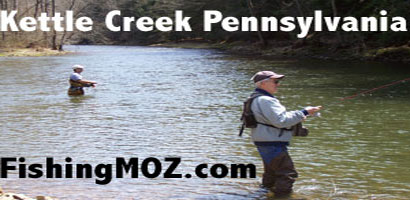So we're approaching trout season in many states across the country including Pennsylvania, New York, and other states that stock trout in streams for anglers. Stock trout are often easy to catch and will bite almost anything but there are several things you can do to increase your catch this year for the first day of trout season.
Anglers often fish for stocked trout by using either fly fishing equipment or spinning gear. Fly anglers can do quite well with using streamers, nymphs, and dry flies if a hatch comes off the stream. Fishermen using spinning gear will catch their limit of trout using spinners and bait such as wax worms, red worms, Powerbait, maggots and minnows. Here are some tips, which will increase your creel when fishing for trout on the opening days of trout season.
Stocked Trout Fishing Tips - Spinning Gear
Light Line - Often anglers will use to heavy of a line when fishing for trout. Anglers should never go over 6 lb test and 4 lb test is generally the best choice. I like fishing with fluorocarbon due to it being almost invisible in the water, which keeps from spooking the trout.
Sensitive Lightweight Rod - Leave the stiff bass rods at home and get yourself a 5 foot light or medium light rod. If you are going to be fishing a bigger stream or river a 6 or 7 foot lightweight rod will give you a big advantage when it comes to getting a natural drift and they cast further than a shorter rod.
Trout Bait - Keep it fresh! Fresh bait is critical when it comes to trout fishing a great bait choices are wax worms, maggots, and red worms. Also if you are lucky enough to find them trout love wood sawyers. If you really want a big trout live minnows threaded with a hook is a guaranteed big trout catcher. Probably minnows are the best performer when fishing for stocked trout they just take some time to rig and can be a little cumbersome to carry with you on a stream.
Hooks - Little hooks is what you need when fishing for trout, often I will see trout fishermen using way to big of a hook for trout which will spook most trout and leave you with an empty stringer. Keep your hook size around a size 10, 12, or 14 and if you're fishing maggots go smaller. If you're fishing with live minnows and threading them through the mouth and out the anus you will need a treble hook to attach which keeps your minnow straight when swinging in the current.
Sinkers - Again this is an area in which I see to many anglers either using too much weight or not enough weight. The trick is to put enough sinkers on to feel the bottom and to be gently bouncing across the bottom.
The Cast - If fishing a stream with current you want to cast upstream at 11 o'clock and let your bait drift with the current until it reaches the end of the drift then reel in and cast again. If you are fishing with spinners you want to cast at 12:30 o'clock and reel your spinner in at varying speeds. Try reeling fast then try reeling slower let the trout tell you how they want the spinner. Also don't be afraid to twitch the spinner in the current, which makes it look like a darting minnow in the current.
Stocked Trout Tips - Fly Fishing
If you are fishing with fly fishing equipment some great fly choices for stocked trout are bead head woolly buggers in black and olive, prince nymphs, hare's ear nymphs, and wet flies. Also if you happen to be fishing when a hatch comes off on creek dry flies such as march browns, adams, and wolfs will provide you with plenty of action. Remember it's always best to try to match the hatch that is coming off and a good practice is to stop by a local fly shop and find out what flies are coming off at any given time.
Stocked Trout Tips - The Location
Finding stocked trout is generally pretty easy due to most streams are stocked with a stocking truck which can only be driven to locations with road access. Generally trout are stocked in holes along side the road with easy access. This doesn't mean that these are the only locations, which one can find stocked trout. Trout will migrate in stream and spread out, but the majority of the trout will move to the deepest water available to them due to heavy fishing pressure. Other good locations are the head of the holes where there is faster water leading into the deeper water and the tailout of a hole.
